The Gift of South Dakota
Subscriptions to South Dakota Magazine make great gifts!
Subscribe today — 1 year (6 issues) is just $29!
Prairie Isn’t Prairie Without Sky
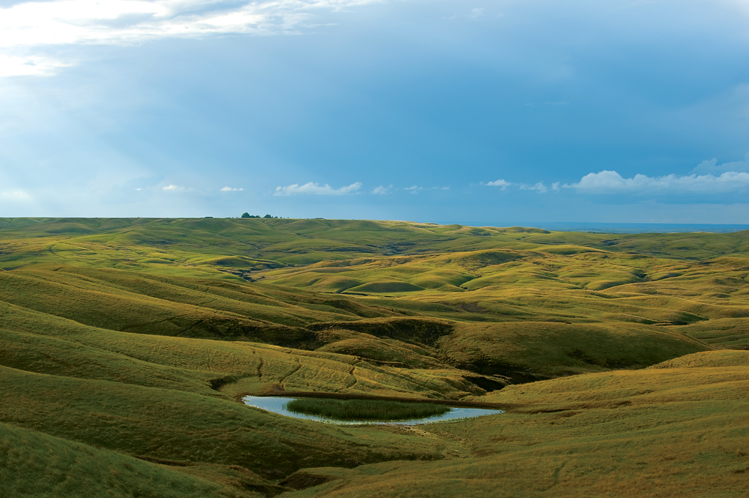 |
| Sunlight illuminates the rolling prairie north of Mission Ridge, near the confluence of the Cheyenne and Missouri rivers. |
To begin to see the prairie, walk away from buildings, power poles, asphalt, away from the sound of motors, away from anything electronic, especially anything that beeps. Walk in the grass that reaches perhaps to your ankles, lithe, whippy grass that has evolved with fewer than 16 inches of moisture a year. Walk until the only sound is the wind combing that grass and the chitter of a flock of horned larks somewhere above and behind you: the invisible birds of the plains. Walk and breathe deeply, inhale clear down to your toes, that clean, indefinable smell of grass that has never known chemical fertilizer, grass that holds man’s fate in its slender stems.
Prairie grass stands close to its ancestors; grass specializes in simplification. Wind-pollinated, grass flowers need no heady fragrance. No honey, no splashy colors. Some grasses do reproduce by flowering, but others spread by underground stems that creep sometimes through the grittiest, grayest, least fertile soil on the planet.
Of all the plants on earth, grass is most important to man. From grass like this evolved all the breadstuff we eat: corn, wheat, oats, rye, barley, rice, sugarcane. “It yields no fruit in earth or air,” said John James Ingalls, a Kansas senator, “and yet should its harvest fail a single year, famine would depopulate the world.” And Rumi, a Sufi mystic who lived from 1207 to 1273, said, “One half the planet is grass. The other half grazing.”
Only standing in undisturbed prairie grass can you truly appreciate prairie sky. Stand tall. Tilt your face to the sky; open your eyes wide. Turn your head from one shoulder to the other, and then turn around and do the same so you can see the whole bowl of blue, frothy with clouds.
Look carefully around you. You should see no sign of habitation. White settlers sensibly put their houses in valleys and low places close to water sources, following the practice of earlier Native residents both for practicality, and for safety from storms. And a low location offered concealment, too, from marauders, from wind. Most ranches in arid country lie down long winding gravel roads from the nearest highway, down in any available dip. Perhaps the house is sheltered by windbreak trees. The corrals are downhill, to protect the water supply.
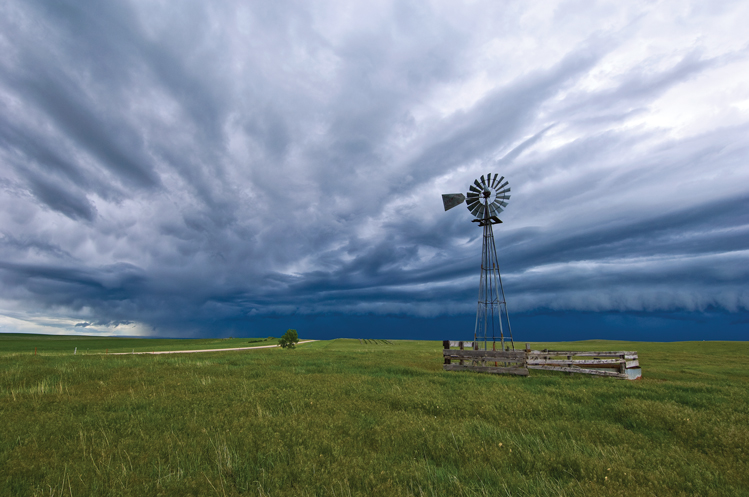 |
| “Only standing in undisturbed prairie grass can you truly appreciate prairie sky,” writes Hasselstrom. Such prairie can be seen in Harding County. |
Only modern settlers are foolish enough, and rich enough, to plunk houses on top of hills. A hilltop house requires a deep well and powerful pumps to bring water to the surface. A house atop a hill must contain a monster furnace to fill it with heat when the thermometer reads 35 below zero and the winds are blowing 50 miles an hour. But most modern residents no longer earn a living from the land, so they situate their houses for the view without realizing that they have doubled, tripled the costs of their own living. They’ve also destroyed the prairie for everyone within sight of their misbegotten lodgings. If anything like this is in sight, walk farther. Use the time to breathe deeply.
The prairie sky. Standing with your eyes open, you must be able to see a harrier hawk rise up from that ridge to the south, wings extended and gleaming bronze in sunlight. Watch her fly, swoop, dip, glide and hover across the face of the ridge and down a half mile to the dam where the ducks scatter under her shadow.
Then the harrier tilts her wings and is lifted by the wind up to soar over your head, turning one eye then the other to see you clearly. Turn your head and watch as she leans first one way then the other against the wind, circling, pitching, angling down along fence lines until finally she drops on a vole or mole in the grass.
Wait. Wait.
The hawk rises, lifts great wings, ascends to the top of a tree at the very edge of your vision. With binoculars you can see the smooth neck bend as she begins to feed on a morsel of prairie life, a morsel of grass made flesh. Like yours.
Breathe deeply. Look around again. A few power poles may trace a lacy filigree at the edges of the blue, and a few trees may gather like seashore foam fringing the blue world overhead. But that’s all. A true prairie sky is clean, without neon, without smog, without the chatter of aircraft. No artificial lights shatter the perfect darkness of the night.
Only with the whole sky as background can you really see the great horned owl drop from the cottonwood near the house, swing around behind the windbreak junipers and alight on the branch of another cottonwood where she instantly looks like a broken-off stump. Only by watching for a long time will you see her glide out over the grass, drop on a rabbit, hold it down with one taloned foot while she turns her head, scouting for danger.
In the whole sky, you can really see the flock of red-winged blackbirds leap out of the cottonwood by the dam, and swing a mile around the hayfield, their gold and red wing patches signaling in the sun. Then they swoop, calling and whistling, into the branches of the two dead cottonwoods by the house. You can see barn swallows demonstrating their daring flying, zipping under the deck of the house, through the broken pane in the barn window, between the bars of the corral gate.
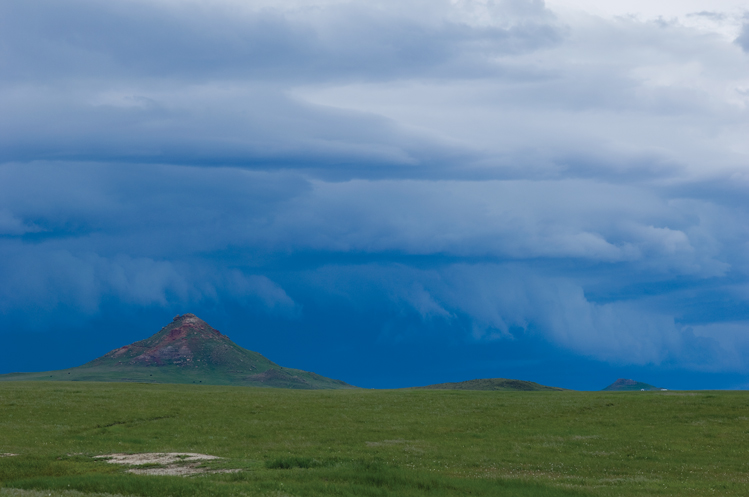 |
| A thunderstorm approaches this otherwise peaceful prairie in Harding County, north of Buffalo. |
Only the whole prairie sky allows you to properly see clouds. The Navajo have a proverb: “The clouds must look like many sheep before the rains will come.” Look up: When you see flat-bottomed cumulus clouds with puffy heads arranged as evenly as sheep in a pasture or as tiles on the floor, find your umbrella.
Late in the summer, look forward to the towering cumulus clouds called “cauliflower” because their crowns are boiling upward into blue sky like bubbles in a bathtub. Then watch out for the revealing shape of an anvil against the dark blue: ice crystals building into a thunderstorm likely to bring hail that can flatten a hayfield in minutes, killing birds, rabbits, damaging man’s possessions. After hot days, beware of the pouch-like formations called “mammy” clouds that may signal a tornado.
In the wide prairie sky, you can spot the undulating wing beats from a distance, and watch until they come close enough to identify a great blue heron, flying from the nesting spot on Battle Creek 6 miles to the north to this shrinking pond on the prairie where it will stand on one leg for a few hours while hunting frogs. In summer, the heron may be almost invisible among the crowds of sunflowers along the edges of the pond. In winter, the heron is a cultural icon, a Chinese painting against the silver water as it slowly freezes in the falling snow.
Only the whole sky is large enough so you can hear the shooping and chortling and chuckling of the sandhill cranes miles away. You turn your head this way and that, eyes straining for a sight of the wavering V shapes. Lie down; relax. Let your eyes slide over the sky. There, far to the north, the line thinner than a pencil leaves, growing closer and thicker as the sounds drop to you, hooting and cooing and laughing. The shifting line of birds, mighty wings outstretched, is headed south to gather on the Platte River in Nebraska. Only the whole sky is enough so you can see several V’s of them — 20, 60, 200 cranes at a time, breaking into groups, circling up the sky until they hit a fast wind that shoots them south, deploying into another ragged arrow shape.
Only the whole sky will hold and amplify the thunder that begins somewhere to the north. The ground shudders as the clouds shimmer: a B-1 bomber takes off from Ellsworth Air Force Base, blasting upward until it is only a silver dot, trailing white vapor into the sunset. Headed perhaps for Iraq, it booms its message of war over this quiet landscape. Only the whole sky allows you to understand the immensity of its power, its importance. Think of it: filled with munitions, and with men and women whose job is to protect this prairie and everything connected to it. Only the whole sky can contain their gallantry, and their work.
The whole sky must be visible for proper appreciation of a sunset. I may be facing east when I notice puffy clouds turning from gray to pink. Instinctively, I look west, where the sunset is supposed to be. It’s there too: golden rays shooting up into the sky or turning the underside of a sky full of clouds pink and gold. When clouds are heavy in the west, sometimes the sunset can’t be seen at all where it should be, and the reflection in the east is so vivid I distrust my sense of direction.
While my mind wrestles with a writing project, I often search for a quotation, a summary, a comforting reminder that someone wiser than I am has considered the same subject. This time, I turned to Henry David Thoreau: “Thank God men cannot fly,” he said, “and lay waste the sky as well as the earth.” Oh Henry, did you speak too soon?
The decisions that can protect the prairie sky rest with us. Without the grass, without the harrier and the owl, the whooping cranes and the redwing blackbirds, the prairie can’t exist.
Editor’s Note: This story is revised from the July/August 2010 issue of South Dakota Magazine. To order a copy or to subscribe, call (800) 456-5117.


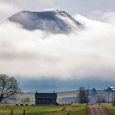
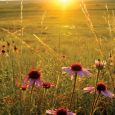
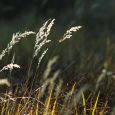
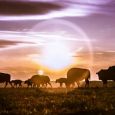
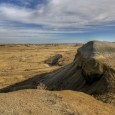
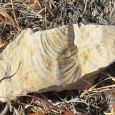


Comments